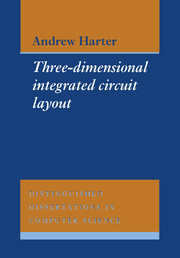Book contents
- Frontmatter
- Abstract
- Preface
- Contents
- List of Figures
- List of Plates
- List of Tables
- List of Algorithms
- Glossary of Terms
- 1 Introduction
- 2 Two-Dimensional Chip Design
- 3 Three-Dimensional Chip Technology
- 4 Three-Dimensional Circuit Topology
- 5 Three-Dimensional Cell Tessellation
- 6 Three-Dimensional Abutment System
- 7 Abutment System Configuration
- 8 Abutment System Evaluation
- 9 Conclusions
- A Layout Editor Configuration
- B Layout System Data Structures
- C Cell Description Rules
- D Circuits
- References
- Index
6 - Three-Dimensional Abutment System
Published online by Cambridge University Press: 05 May 2010
- Frontmatter
- Abstract
- Preface
- Contents
- List of Figures
- List of Plates
- List of Tables
- List of Algorithms
- Glossary of Terms
- 1 Introduction
- 2 Two-Dimensional Chip Design
- 3 Three-Dimensional Chip Technology
- 4 Three-Dimensional Circuit Topology
- 5 Three-Dimensional Cell Tessellation
- 6 Three-Dimensional Abutment System
- 7 Abutment System Configuration
- 8 Abutment System Evaluation
- 9 Conclusions
- A Layout Editor Configuration
- B Layout System Data Structures
- C Cell Description Rules
- D Circuits
- References
- Index
Summary
Introduction
Outline
The purpose of this chapter is to present a detailed description of the design and implementation of an automated layout system based on the principle of three-dimensional cell tessellation proposed in the previous chapter. The description begins with a statement of the experimental aims and required features of the layout system and continues with details of circuit representation. This is followed by details of the design and implementation of cell and layout representation, and of the abutment algorithms. A number of important properties which abutting layouts must possess are highlighted in the details of the algorithms. Finally, the control of the abutment process is discussed through the construction of merit functions and mechanisms for combining elements of the algorithms.
Experimental requirements
A number of requirements of the layout system are stated at the outset. These are:
Ability to specify a range of cell shapes,
Ability to specify the connection interface,
Flexible merit function and layout control,
Full layout automation requiring no manual editing,
Ability to handle circuits of non-trivial size,
Extraction of layout data for comparison,
A high degree of automated layout validation.
Although the cell model for abutment experiments is primarily intended to be the cube, the system is nevertheless required to be sufficiently general to be able to perform layout using one of a number of cell models. Specification of the cell model includes both the shape of the cell and the number of connections per face. An important aspect of the experiment is the determination of suitable merit functions and layout control.
- Type
- Chapter
- Information
- Three-Dimensional Integrated Circuit Layout , pp. 99 - 122Publisher: Cambridge University PressPrint publication year: 1991



